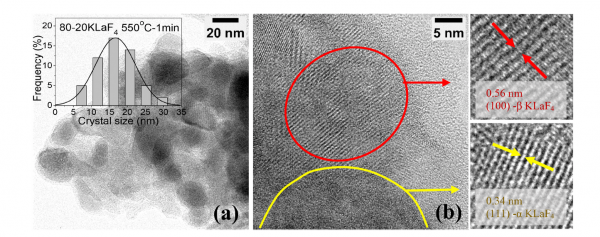Nd3+-doped- SiO2–KLaF4 oxyfluoride glass-ceramics prepared by sol-gel
Neodymium doped SiO2–KLaF4 oxyfluoride Glass-Ceramics (GCs) containing 10 and 20 mol % of KLaF4 NanoCrystals (NCs) were prepared for the first time by sol-gel. Site-selective emission and excitation spectra confirmed the incorporation of Nd3+ ions in α-KLaF4 and β-KLaF4 crystalline phases with emission of Nd3+ most predominant in the β-KLaF4 NCs.
In the last few decades the growing interest in GCs has revealed the potential of this new class of optical materials, the properties of which, especially the optical ones, significantly improved with controlled crystallization of certain crystalline phases. In the particular case of KLaF4 nanocrystals, the phonon energy was found to be 262 cm–1, much lower than most fluorides, making it of interest as an efficient host matrix for green, red, and blue up-conversion emission through appropriate doping. Although successful processing of KLaF4-GCs by Melt-Quenching (MQ) has been reported, preparation by the sol-gel route has not. The sol-gel method offers the possibility of obtaining GCs using a cheap, flexible, and melt-free synthesis route with the possibility of processing as bulk, thin film, and powder materials. Sol-gel also allows the final crystal fraction to be controlled by avoiding fluorine loss, which occurs at high temperature during MQ, and thus optical efficiency may be improved.
In this collaborative work carried out by the groups led by Alicia Durán (ICV-CSIC) and Rolindes Balda (CFM, UPV/EHU), transparent SiO2–KLaF4 GCs were, for the first time, successfully obtained by the sol-gel process after heat treatments for just 1 min. Cubic (α-phase) and hexagonal (β-phase) KLaF4 phases appeared for all heat-treatments, with increasing temperature favoring the cubic-to-hexagonal phase transformation. HR-TEM images confirmed the coexistence of cubic and hexagonal phases with similar nanocrystal sizes to those estimated by XRD. The spectral features of the emission and excitation spectra together with the lifetimes obtained in the GC sample by using site-selective laser spectroscopy in the 4I9/2 → 4F5/2 transition confirm the incorporation of Nd3+ ions in both crystalline phases. The predominant emission of Nd3+ ions corresponds to the β-KLaF4 hexagonal phase. The optical behavior differs from that obtained in GC samples prepared by MQ, where the less efficient cubic phase was predominant. It may be concluded, therefore, that the sol-gel method favors the growth of the hexagonal KLaF4 β-phase, which in general has a higher quantum yield than the cubic polymorph, and is thus a very promising synthesis route for different photonic applications.

Figure 1: (a) HR-TEM image of 80SiO2-20KLaF4 sample treated at 550ºC for 1 min with the crystal size distribution. (b) Details of the alfa and beta nanocrystals with their corresponding plane distance.

Figure 2: Low temperature emission spectra obtained under excitation at (a) 1046 nm (beta phase) and (b) 1055 nm (alfa phase) for the GC sample.



